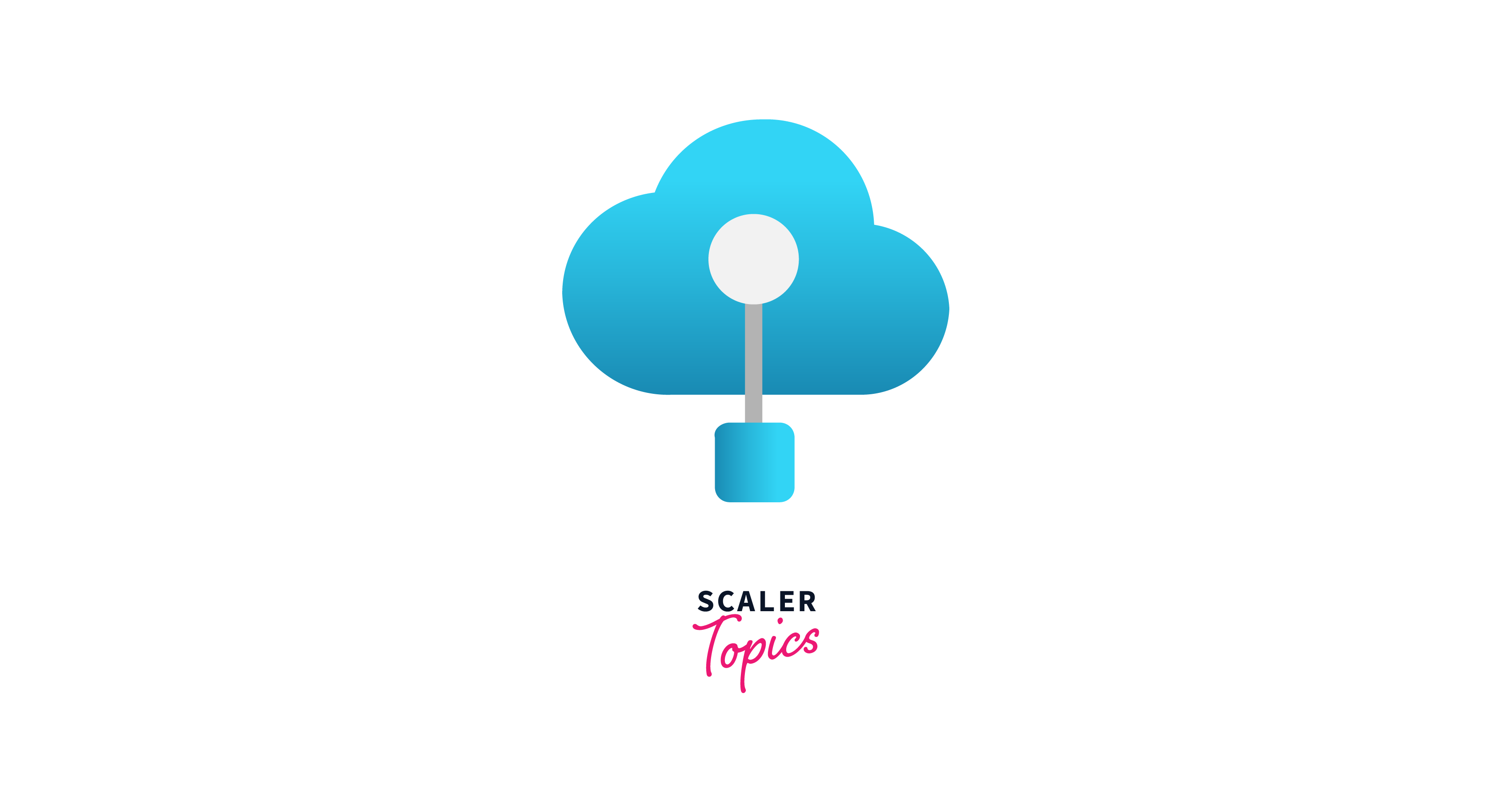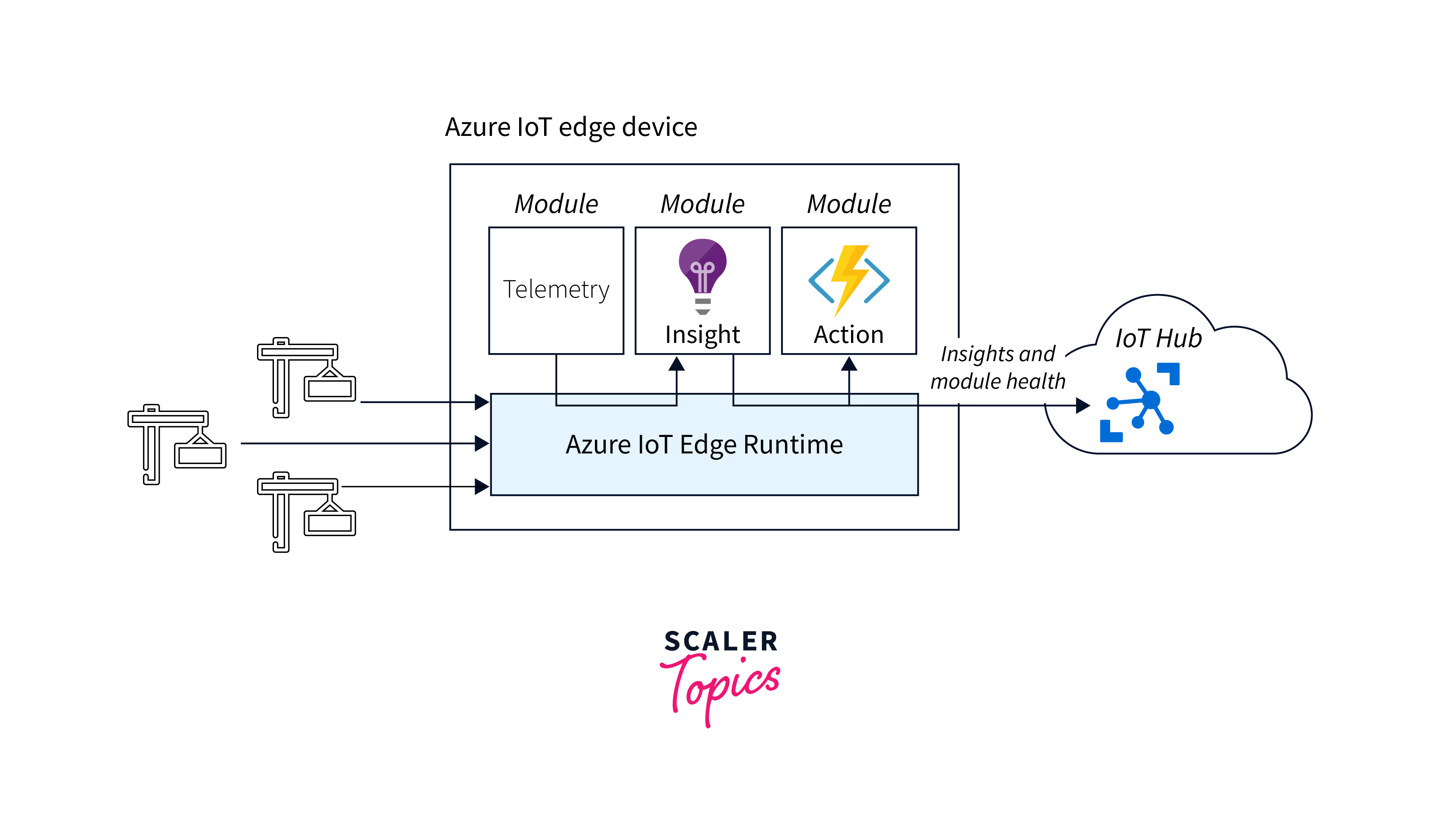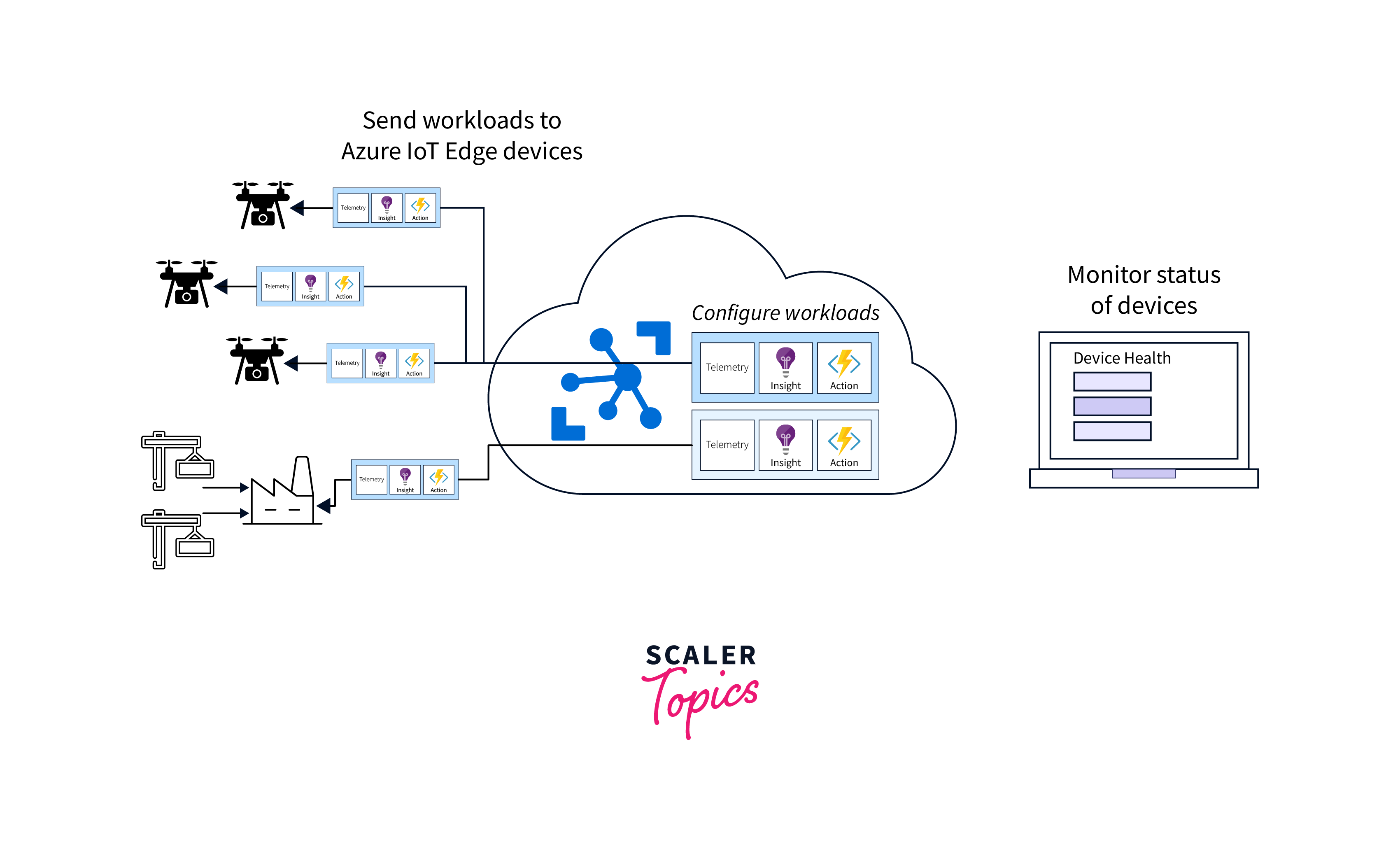Azure Iot Edge
Overview
Azure IoT Edge is a Microsoft service that enables IoT devices to run custom and cloud-based applications locally, enhancing efficiency and reducing latency by processing data at the edge. It provides a runtime for module management, security, and local data processing, allowing seamless integration with Azure IoT Hub and Azure services.
What is Azure IoT Edge?
Azure IoT Edge is a cloud service by Microsoft that enables IoT (Internet of Things) devices to run cloud intelligence directly on them. It allows devices to process data locally, reducing the need for constant data transmission to the cloud. With Azure IoT Edge, you can deploy and manage containerized workloads on IoT devices, enabling real-time analysis, reducing latency, and enhancing efficiency in IoT solutions.

Key Features:
- Custom and Cloud Logic: Azure IoT Edge enables the deployment of custom code and cloud-based applications on IoT devices. These applications, referred to as modules, perform tasks like data processing, analytics, and communication.
- IoT Edge Runtime: The IoT Edge runtime is a core component that manages module deployment and execution on edge devices. It also ensures security standards and reports module health to the cloud for remote monitoring.
- Security: Azure IoT Edge prioritizes security, implementing features like secure boot, device identity, and access control to safeguard devices and data.
- Local Processing: Local data processing at the edge minimizes the need to send all data to the cloud, reducing latency and bandwidth usage.
- Cross-Platform Support: Azure IoT Edge is compatible with a wide range of IoT devices, supporting both Linux and Windows operating systems and abstracting hardware details for flexibility.
Use Cases
Azure IoT Edge is employed in various industries and scenarios. For instance, it's commonly used to deploy artificial intelligence (AI) and machine learning models to gateway devices, which aggregate and process data from other on-premises devices. This localized intelligence is valuable in predictive maintenance, anomaly detection, and real-time decision-making.
What are the components of Azure Iot Edge?
Azure IoT Edge comprises several key components:
- IoT Edge Runtime: This component is responsible for managing and executing modules on IoT devices. It supports Docker containers and enables modules to run in a secure and isolated environment.
- IoT Edge Hub: It is a message broker that facilitates communication between modules and the cloud. It routes messages to and from Azure IoT Hub, handling secure and efficient data transfer.
- Modules: These are units of execution within IoT Edge, typically packaged as Docker containers. Modules perform specific tasks such as data processing, analytics, or interfacing with sensors and actuators.
- IoT Edge Security: This layer ensures the security of the IoT Edge device and its modules, providing features like secure boot, device identity, and certificate management.
- IoT Edge Agent: The agent is responsible for module management, deployment, and monitoring. It communicates with the IoT Edge Hub and oversees module lifecycles.
- IoT Edge Marketplace: This is a repository for IoT Edge modules, where you can find and deploy pre-built modules or create custom ones for specific tasks.
Together, these components enable Azure IoT Edge to extend cloud capabilities to edge devices, enhancing IoT solutions with local processing, reduced latency, and improved efficiency.
IoT Edge modules
IoT Edge modules are self-contained units of execution that run on Azure IoT Edge devices. These modules are typically packaged as Docker containers and serve various purposes within an IoT solution. Some common functions of IoT Edge modules include:
- Data Processing: Modules can process and filter data generated by sensors and devices, allowing for real-time analytics and insights at the edge.
- Communication: Modules enable devices to interact with other devices, cloud services, or external systems, facilitating data exchange and coordination.
- Security: Some modules focus on enhancing the security of IoT devices and their data, providing encryption, authentication, and access control.
- Custom Logic: IoT Edge modules can execute custom business logic, allowing for specific actions or decision-making at the edge.
- Protocol Translation: Modules can translate data between different communication protocols to ensure interoperability in heterogeneous IoT environments.
- Machine Learning and AI: Specialized modules can run machine learning or artificial intelligence models for predictive maintenance, anomaly detection, and more.
IoT Edge modules are managed and orchestrated by the IoT Edge Agent, allowing for flexible and scalable deployment of edge computing solutions. This approach brings intelligence and processing closer to IoT devices, reducing the need for constant data transmission to the cloud and improving efficiency in various IoT applications.
IoT Edge runtime
The Azure IoT Edge runtime is a core component of Azure IoT Edge, designed to enable edge computing capabilities for IoT devices.

Key features and functions of the IoT Edge runtime include:
- Module Management: It manages the deployment, execution, and lifecycle of IoT Edge modules, which are typically containerized units of code responsible for specific tasks like data processing, analytics, or communication.
- Security: The runtime ensures the security of IoT Edge devices by enforcing secure boot, device identity, and access control, safeguarding both the devices and the data they handle.
- Local Processing: It facilitates local data processing on edge devices, reducing the need to send all data to the cloud. This helps in minimizing latency and bandwidth usage while enhancing real-time decision-making at the edge.
- Communication: The runtime handles communication between IoT Edge devices, between modules on the same device, and between IoT Edge devices and Azure IoT Hub, enabling data transfer, telemetry, and configuration updates.
- Monitoring and Reporting: It monitors the health and status of IoT Edge modules and reports this information to the cloud for remote monitoring and management, ensuring that modules are always running as intended.
- Cross-Platform Support: The IoT Edge runtime is compatible with a wide range of IoT devices, supporting both Linux and Windows operating systems, and abstracting hardware details to provide flexibility in deployment.
By incorporating the Azure IoT Edge runtime, organizations can extend cloud capabilities to the edge, enabling intelligent data processing and analytics closer to IoT devices, thereby enhancing efficiency, reducing latency, and improving the responsiveness of IoT solutions.
IoT Edge cloud interface
The IoT Edge cloud interface, in the context of Azure IoT Edge, addresses the challenges of managing diverse IoT devices at scale. It allows for centralized control and management of IoT workloads.

Here's how it works:
- Workload Configuration: You can create and configure specific workloads or modules tailored to a particular type of device within the Azure IoT Central platform.
- Workload Deployment: The cloud interface enables you to deploy these configured workloads to a group or set of devices, ensuring consistency and scalability across your IoT solution.
- Remote Monitoring: Cloud services provide real-time monitoring and oversight of workloads running on devices in the field. This allows you to detect and address any issues or misbehaving devices, even when dealing with a large number of geographically dispersed devices.
By integrating Azure IoT Edge with Azure IoT Central and leveraging the IoT Edge cloud interface, you can streamline the management and orchestration of IoT workloads, making it more efficient to handle a diverse and distributed fleet of IoT devices. This centralized approach enhances control and simplifies the deployment of custom workloads across your IoT solution.
Deployment Considerations
When deploying Azure IoT Edge across various IoT devices, it's crucial to account for diverse hardware capabilities and operating systems. Ensure that selected hardware meets the minimum requirements, such as CPU and memory specifications, outlined by Microsoft for optimal performance. Selecting a compatible operating system is equally vital, with Azure IoT Edge supporting popular choices like Linux and Windows.
Performance considerations necessitate a thorough assessment of the IoT device's processing power, memory, and network capabilities. Fine-tune workload distribution and containerized applications to align with the specific strengths and limitations of each device, optimizing overall system efficiency.
Azure IOT Edge VS Cloud
Processing data at the edge with Azure IoT Edge offers distinct advantages compared to traditional cloud-based processing:
- Latency and Real-time Decision-Making:
- Edge Computing: Azure IoT Edge allows for local processing of data on IoT devices, reducing latency by minimizing the round-trip time to the cloud. This is particularly advantageous in scenarios where real-time decision-making is critical, such as in industrial automation or autonomous systems.
- Cloud Computing: Traditional cloud-based processing involves transmitting data to centralized servers, which can introduce delays. In applications where immediate response is essential, edge computing proves superior by enabling on-the-spot analytics and decision-making.
- Bandwidth Efficiency:
- Edge Computing: By processing data locally, Azure IoT Edge minimizes the need to transmit large volumes of raw data to the cloud, leading to more efficient bandwidth utilization. This is especially beneficial in scenarios with limited or costly network connectivity, such as remote locations or constrained environments.
- Cloud Computing: Transmitting extensive datasets to the cloud for processing can strain network resources and result in increased operational costs, making edge computing preferable for scenarios where bandwidth efficiency is a priority.
- Privacy and Security:
- Edge Computing: Keeping sensitive data on the device enhances privacy and security, as critical information can be processed locally without traversing external networks. This is advantageous in industries with stringent data privacy regulations, such as healthcare or finance.
- Cloud Computing: Storing and processing data in the cloud may raise concerns regarding data privacy and security, especially when dealing with sensitive information. Edge computing mitigates these risks by processing sensitive data closer to the source.
Advantages of Edge Computing:
- Edge computing is particularly advantageous when low-latency, real-time processing is crucial.
- It proves beneficial in scenarios with limited or costly network connectivity, optimizing bandwidth usage.
- Enhanced privacy and security are achieved by processing sensitive data locally, reducing exposure to external networks.
Conclusion
- Azure IoT Edge is a Microsoft service that extends cloud intelligence to Internet of Things (IoT) devices by enabling them to run custom and cloud-based applications locally.
- Azure IoT Edge comprises the IoT Edge runtime, IoT Edge modules, and IoT Edge cloud interface, providing a comprehensive solution for edge computing in IoT.
- Azure IoT Edge enables organizations to deploy and run cloud intelligence directly on IoT devices, facilitating real-time data processing and reducing latency.
- Common use cases include edge analytics for predictive maintenance and local decision-making, enhancing efficiency in industries such as manufacturing, energy, and healthcare.
- IoT Edge modules are self-contained units of execution that run on IoT Edge devices, performing tasks like data processing and communication.
- The IoT Edge runtime manages module deployment, security, and local data processing on edge devices, enhancing the efficiency and security of IoT solutions.
- IoT Edge Cloud Interface facilitates centralized management, configuration, and monitoring of IoT workloads at scale, streamlining control and oversight of diverse IoT devices.
